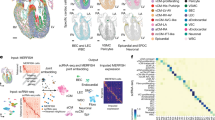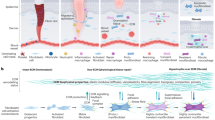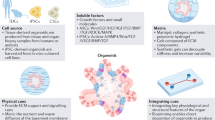Abstract
Amniogenesis—the development of amnion—is a critical developmental milestone for early human embryogenesis and successful pregnancy1,2. However, human amniogenesis is poorly understood due to limited accessibility to peri-implantation embryos and a lack of in vitro models. Here we report an efficient biomaterial system to generate human amnion-like tissue in vitro through self-organized development of human pluripotent stem cells (hPSCs) in a bioengineered niche mimicking the in vivo implantation environment. We show that biophysical niche factors act as a switch to toggle hPSC self-renewal versus amniogenesis under self-renewal-permissive biochemical conditions. We identify a unique molecular signature of hPSC-derived amnion-like cells and show that endogenously activated BMP–SMAD signalling is required for the amnion-like tissue development by hPSCs. This study unveils the self-organizing and mechanosensitive nature of human amniogenesis and establishes the first hPSC-based model for investigating peri-implantation human amnion development, thereby helping advance human embryology and reproductive medicine.
This is a preview of subscription content, access via your institution
Access options
Subscribe to this journal
Receive 12 print issues and online access
$259.00 per year
only $21.58 per issue
Buy this article
- Purchase on Springer Link
- Instant access to full article PDF
Prices may be subject to local taxes which are calculated during checkout





Similar content being viewed by others
References
Dobreva, M. P., Pereira, P. N., Deprest, J. & Zwijsen, A. On the origin of amniotic stem cells: of mice and men. Int. J. Dev. Biol. 54, 761–777 (2010).
Luckett, W. P. The development of primordial and definitive amniotic cavities in early Rhesus monkey and human embryos. Am. J. Anat. 144, 149–167 (1975).
Ferner, K. & Mess, A. Evolution and development of fetal membranes and placentation in amniote vertebrates. Respir. Physiol. Neurobiol. 178, 39–50 (2011).
Warmflash, A. et al. A method to recapitulate early embryonic spatial patterning in human embryonic stem cells. Nat. Methods 11, 847–854 (2014).
Taniguchi, K. et al. Lumen formation is an intrinsic property of isolated human pluripotent stem cells. Stem Cell Rep. 5, 954–962 (2015).
Deglincerti, A. et al. Self-organization of the in vitro attached human embryo. Nature 533, 251–254 (2016).
Shahbazi, M. N. et al. Self-organization of the human embryo in the absence of maternal tissues. Nat. Cell Biol. 18, 700–708 (2016).
O’Leary, T. et al. Tracking the progression of the human inner cell mass during embryonic stem cell derivation. Nat. Biotechnol. 30, 278–282 (2012).
Nakamura, T. et al. A developmental coordinate of pluripotency among mice, monkeys and humans. Nature 537, 57–62 (2016).
Lancaster, M. et al. Cerebral organoids model human brain development and microcephaly. Nature 501, 373–379 (2013).
Enders, A. C., Schlafke, S. & Hendrickx, A. G. Differentiation of the embryonic disc, amnion, and yolk sac in the rhesus monkey. Am. J. Anat. 177, 161–185 (1986).
Ben-David, U., Nudel, N. & Benvenisty, N. Immunologic and chemical targeting of the tight-junction protein Claudin-6 eliminates tumorigenic human pluripotent stem cells. Nat. Commun. 4, 1992 (2013).
Buxboim, A., Rajagopal, K., Brown, A. E. X. & Discher, D. E. How deeply cells feel: methods for thin gels. J. Phys. Condens. Matter. 22, 194116 (2010).
Fu, J. et al. Mechanical regulation of cell function with geometrically modulated elastomeric substrates. Nat. Methods 7, 733–736 (2010).
Thiery, J., Acloque, H., Huang, R. & Nieto, M. Epithelial-mesenchymal transitions in development and disease. Cell 139, 871–890 (2009).
Mendjan, S. et al. NANOG and CDX2 pattern distinct subtypes of human mesoderm during exit from pluripotency. Cell Stem Cell 15, 310–325 (2014).
Zhang, X. Q. et al. Pax6 is a human neuroectoderm cell fate determinant. Cell Stem Cell 7, 90–100 (2010).
Sasaki, K. et al. The germ cell fate of cynomolgus monkeys is specified in the nascent amnion. Dev. Cell 39, 169–185 (2016).
Li, Y. C. et al. BMP4-directed trophoblast differentiation of human embryonic stem cells is mediated through ΔNp63(+) cytotrophoblast stem cell state. Development 140, 3965–3976 (2013).
Lee, C. Q. E. et al. What is trophoblast? A combination of criteria define human first-trimester trophoblast. Stem Cell Rep. 6, 257–272 (2016).
Henderson, J. K. et al. Preimplantation human embryos and embryonic stem cells show comparable expression of stage-specific embryonic antigens. Stem Cells 20, 329–337 (2002).
Roost, M. S. et al. KeyGenes, a tool to probe tissue differentiation using a human fetal transcriptional atlas. Stem Cell Rep. 4, 1112–1124 (2015).
Miki, T. & Strom, S. C. Amnion-derived pluripotent/multipotent stem cells. Stem Cell Rev. 2, 133–141 (2006).
Dobreva, M. P. et al. Periostin as a biomarker of the amniotic membrane. Stem Cells Int. 2012, 987185 (2012).
Slieker, R. C. et al. DNA methylation landscapes of human fetal development. PLoS Genet. 11, e1005583 (2015).
Regauer, S., Franke, W. W. & Virtanen, I. Intermediate filament cytoskeleton of amnion epithelium and cultured amnion epithelial-cells—expression of epidermal cytokeratins in cells of a simple epithelium. J. Cell Biol. 100, 997–1009 (1985).
Mallon, B. S. et al. StemCellDB: the human pluripotent stem cell database at the National Institutes of Health. Stem Cell Res. 10, 57–66 (2013).
Pereira, P. N. et al. Amnion formation in the mouse embryo: the single amniochorionic fold model. BMC Dev. Biol. 11, 48 (2011).
Chen, H. M. et al. Transcripts involved in calcium signaling and telencephalic neuronal fate are altered in induced pluripotent stem cells from bipolar disorder patients. Transl. Psychiatry 4, e375 (2014).
Watanabe, K. et al. A ROCK inhibitor permits survival of dissociated human embryonic stem cells. Nat. Biotechnol. 25, 681–686 (2007).
Tse, J. & Engler, A. Current Protocols in Cell Biology Preparation of hydrogel substrates with tunable mechanical properties. Ch. 10 (Wiley, 2010).
Fischer, R., Myers, K., Gardel, M. & Waterman, C. Stiffness-controlled three-dimensional extracellular matrices for high-resolution imaging of cell behavior. Nat. Protoc. 7, 2056–2066 (2012).
Koschwanez, J. H., Carlson, R. H. & Meldrum, D. R. Thin PDMS films using long spin times or tert-butyl alcohol as a solvent. PLoS ONE 4, e4572 (2009).
Shao, Y., Mann, J. M., Chen, W. Q. & Fu, J. P. Global architecture of the F-actin cytoskeleton regulates cell shape-dependent endothelial mechanotransduction. Integr. Biol. 6, 300–311 (2014).
Weng, S. & Fu, J. Synergistic regulation of cell function by matrix rigidity and adhesive pattern. Biomaterials 32, 9584–9593 (2011).
Schneider, C. A., Rasband, W. S. & Eliceiri, K. W. NIH Image to ImageJ: 25 years of image analysis. Nat. Methods 9, 671–675 (2012).
Livak, K. J. & Schmittgen, T. D. Analysis of relative gene expression data using real-time quantitative PCR and the 2−ΔΔC(T) method. Methods 25, 402–408 (2001).
Dobin, A. et al. STAR: ultrafast universal RNA-seq aligner. Bioinformatics 29, 15–21 (2013).
Anders, S., Pyl, P. T. & Huber, W. HTSeq—a Python framework to work with high-throughput sequencing data. Bioinformatics 31, 166–169 (2015).
Robinson, M. D., McCarthy, D. J. & Smyth, G. K. edgeR: a Bioconductor package for differential expression analysis of digital gene expression data. Bioinformatics 26, 139–140 (2010).
Eisen, M. B., Spellman, P. T., Brown, P. O. & Botstein, D. Cluster analysis and display of genome-wide expression patterns. Proc. Natl Acad. Sci. USA 95, 14863–14868 (1998).
Saldanha, A. J. Java Treeview—extensible visualization of microarray data. Bioinformatics 20, 3246–3248 (2004).
Haas, B. J. et al. De novo transcript sequence reconstruction from RNA-seq using the Trinity platform for reference generation and analysis. Nat. Protoc. 8, 1494–1512 (2013).
Love, M. I., Huber, W. & Anders, S. Moderated estimation of fold change and dispersion for RNA-seq data with DESeq2. Genome Biol. 15, 550 (2014).
Subramanian, A. et al. Gene set enrichment analysis: a knowledge-based approach for interpreting genome-wide expression profiles. Proc. Natl Acad. Sci. USA 102, 15545–15550 (2005).
Acknowledgements
We thank K. S. O’Shea, S. Kalantry, T. Miki and W. Shawlot for comments on the manuscript. We are grateful to M. Czerwinski for help with bioinformatics. We thank G. D. Smith at the University of Michigan MStem Cell Laboratories for providing the UM63-1 hESC line and the University of Michigan Pluripotent Stem Cell Core and the Steven Schwartzberg Memorial Fund for the derivation of the 1196a hiPSC line. This work is supported by the National Science Foundation (CMMI 1129611 and CBET 1149401, J.F.), the National Institutes of Health (R21 EB017078 and R01 EB019436, J.F.; R01 DK089933, D.L.G.), and the American Heart Association (12SDG12180025, J.F.). Y.S. is also partially supported by the University of Michigan Rackham Predoctoral Fellowship. The Lurie Nanofabrication Facility at the University of Michigan, a member of the National Nanotechnology Infrastructure Network (NNIN) funded by the National Science Foundation, is acknowledged for support in microfabrication.
Author information
Authors and Affiliations
Contributions
Y.S., K.T., D.L.G. and J.F. designed experiments; Y.S., K.T., R.F.T., X.X., K.M.A.Y. and J.S. performed experiments; K.G. processed RNA-seq results and performed hierarchical clustering; Y.S., K.T., K.G., J.R.S., D.L.G. and J.F. analysed data and wrote the manuscript. D.L.G. and J.F. supervised the project. All authors contributed to the manuscript.
Corresponding authors
Ethics declarations
Competing interests
The authors declare no competing financial interests.
Supplementary information
Supplementary Information
Supplementary Information (PDF 4646 kb)
Supplementary Information
Supplementary Table 1 (XLS 3985 kb)
Supplementary Information
Supplementary Table 2 (XLS 202 kb)
Rights and permissions
About this article
Cite this article
Shao, Y., Taniguchi, K., Gurdziel, K. et al. Self-organized amniogenesis by human pluripotent stem cells in a biomimetic implantation-like niche. Nature Mater 16, 419–425 (2017). https://doi.org/10.1038/nmat4829
Received:
Accepted:
Published:
Issue Date:
DOI: https://doi.org/10.1038/nmat4829
This article is cited by
-
Derivation of human primordial germ cell-like cells in an embryonic-like culture
Nature Communications (2024)
-
Morphogenesis beyond in vivo
Nature Reviews Physics (2023)
-
Dissecting peri-implantation development using cultured human embryos and embryo-like assembloids
Cell Research (2023)
-
Rapid responses of human pluripotent stem cells to cyclic mechanical strains applied to integrin by acoustic tweezing cytometry
Scientific Reports (2023)
-
Morphogenesis in space offers challenges and opportunities for soft matter and biophysics
Communications Physics (2023)



